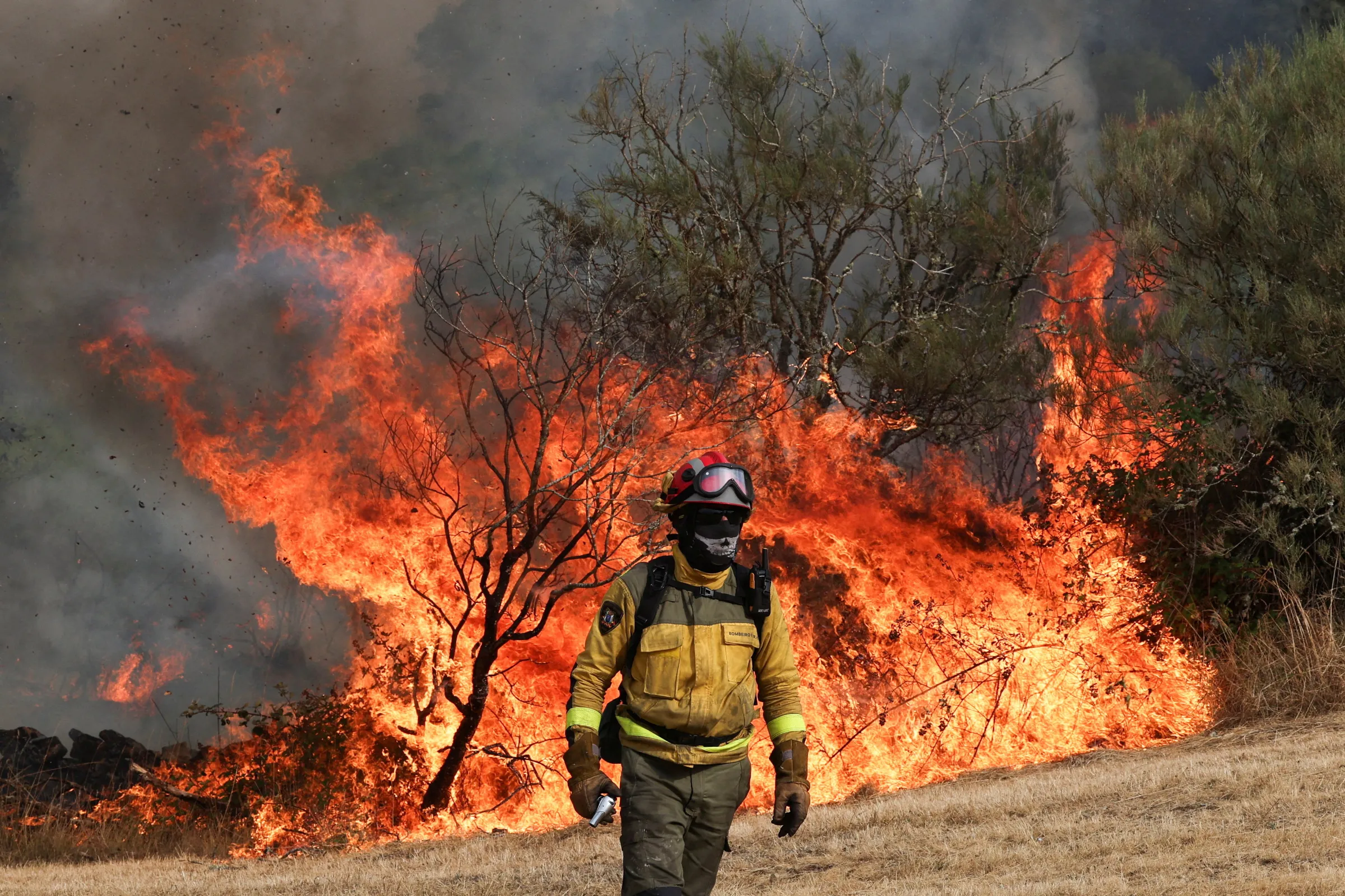Every dollar spent on disaster resilient infrastructure yields between four and $15 in avoided losses.
Resilience: the smartest investment in a world of rising risks

A firefighter changes position during operations to battle a wildfire in the village of Parafita, Galicia region, Spain, August 12, 2025. REUTERS/Violeta Santos Moura
Investing in resilient infrastructure will secure a sustainable and equitable future. It should be top of the agenda at COP30.
Amit Prothi is Director General of the Coalition for Disaster Resilient Infrastructure (CDRI), which fosters multilateral collaboration to support country-led resilience solutions.
As the world marks the International Day for Disaster Risk Reduction on Oct. 13, we must acknowledge a sobering truth: extreme climate events are no longer rare anomalies. They are the new normal.
In recent weeks and months, we have witnessed wildfires in Europe, droughts in east Africa, and floods across Southeast Asia. The cost - human, economic, and ecological - is staggering.
Resilient infrastructure is part of our frontline defence against climate disruption. It stabilises economies, safeguards communities, and preserves development gains.
When infrastructure fails, hazards escalate into catastrophes.
Cyclone Idai in Mozambique wiped out entire towns. In Dominica, a single hurricane inflicted damage worth more than twice the country’s gross domestic product. These tragedies are not just statistics; they are stark reminders that those least responsible for climate change often bear its heaviest burdens.
Globally, disasters already cost us billions. CDRI’s GIRI index estimates annual infrastructure losses from climate change and disasters related to natural hazards, including power facilities, ports, airports, roads, telecommunications, and buildings, to be between $700 billion and $850 billion.
Since 2000, cumulative losses have exceeded $2.3 trillion.
And the future looks bleak if we don’t do anything: flood damage to coastal cities could reach $1 trillion per year by 2050.
African economies lose 2-5% of gross domestic product annually to climate shocks. Small island states can lose multiples of their GDP in a single event. These figures are unsustainable.
Resilience is one of the smartest investments we can make. Every dollar spent on disaster resilient infrastructure yields between four and $15 in avoided losses.
Resilience is achievable
Beyond economics, resilience protects lives, livelihoods, and dignity. Bangladesh’s investment in early warning systems has reduced mortality rates a hundredfold since 1971.
The Netherlands has pioneered Water Squares, public spaces that double as flood retention basins during heavy rainfall.
Timor-Leste has invested in climate-resilient rural roads and irrigation systems. In Zimbabwe, a once-wild thicket has been transformed into a community-run irrigation scheme, ensuring year-round crop production.
At CDRI, we bring together countries, provide expert guidance, and foster multilateral collaboration to support country-led solutions. The evidence is clear: resilience is achievable, and it works.
Yet for every $100 spent on disaster-related aid, only 50 cents goes to prevention.
Governments and lenders must treat resilience not as an afterthought, but as a prerequisite.
The rest is spent on recovery, often too late, and always more expensive. This imbalance traps nations in cycles of vulnerability and rebuilding, rather than enabling stability and long-term prosperity. Reversing this trend represents a critical opportunity.
Resilience as a prerequisite
What’s needed now is evident: make resilience the global standard for how we finance, plan and build. Achieving this by 2050 will take $10 trillion in coordinated investment – embedded across energy, transport, water, housing and digital systems, built into codes, procurement and every project appraisal.
It needs to be top of the agenda at the COP30 climate summit in Brazil in November.
Governments and lenders must treat resilience not as an afterthought, but as a prerequisite. Every loan, every plan should be stress-tested against climate and disaster risks. Public funds must be tied to clear, risk-informed standards.
Public guarantees can unlock private capital, and proven nature-based solutions, like mangrove restoration and green roofs, should be scaled rapidly.
Cities and communities deserve direct, streamlined access to funding. National budgets must allocate for resilience, and every ministry should be responsible for integrating it. Multilateral development banks must expand low-cost finance and guarantees, while the private sector can bring innovation and scale through partnerships, resilience bonds, and insurance-linked instruments.
By investing in resilience, we choose a future that is sustainable, liveable, and equitable. By embedding prevention and preparedness into global financial reforms and prioritising disaster resilient infrastructure, governments can ensure that development gains are not washed away with the next flood or storm.
It is, quite simply, a smart investment in our future.
Any views expressed in this opinion piece are those of the author and not of Context or the Thomson Reuters Foundation.
Related
Latest on Context
- 1
- 2
- 3
- 4
- 5
- 6














